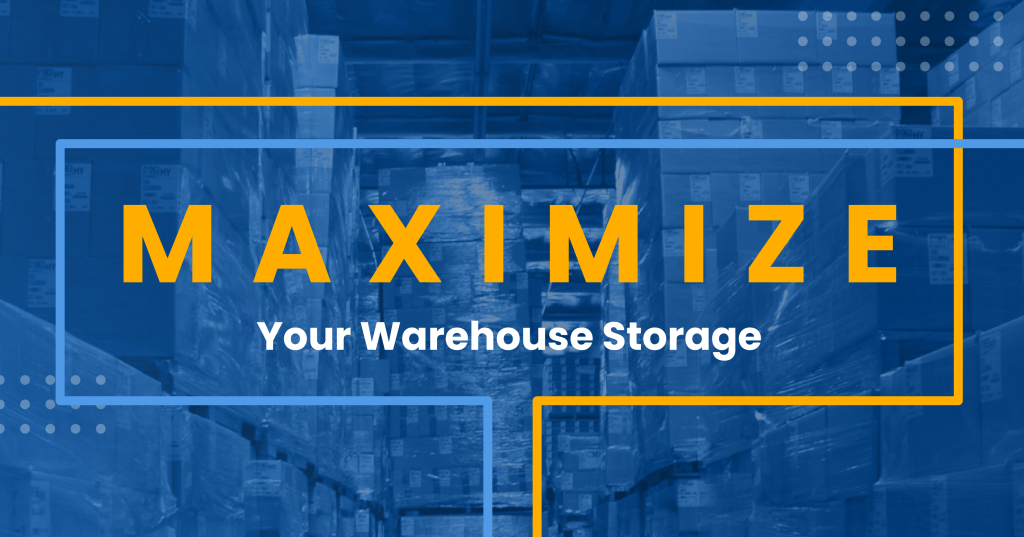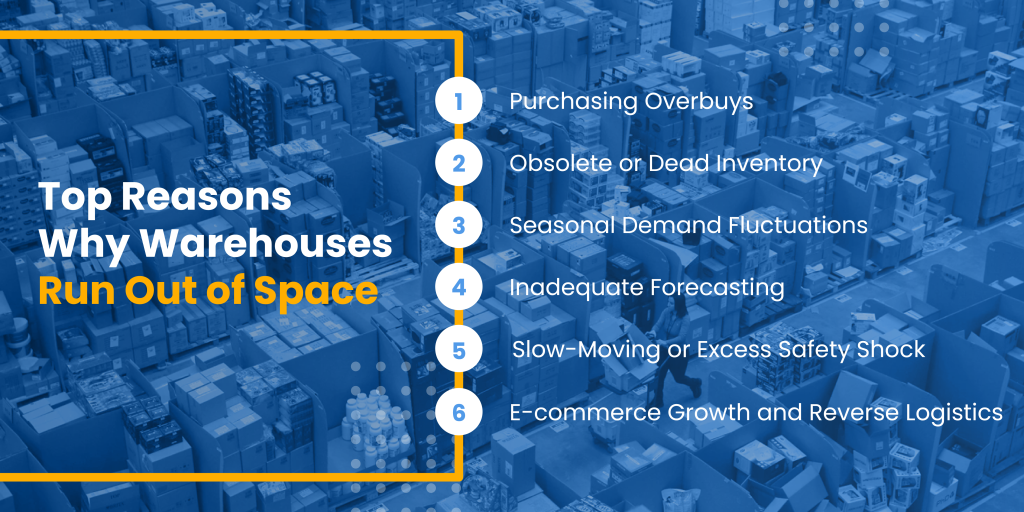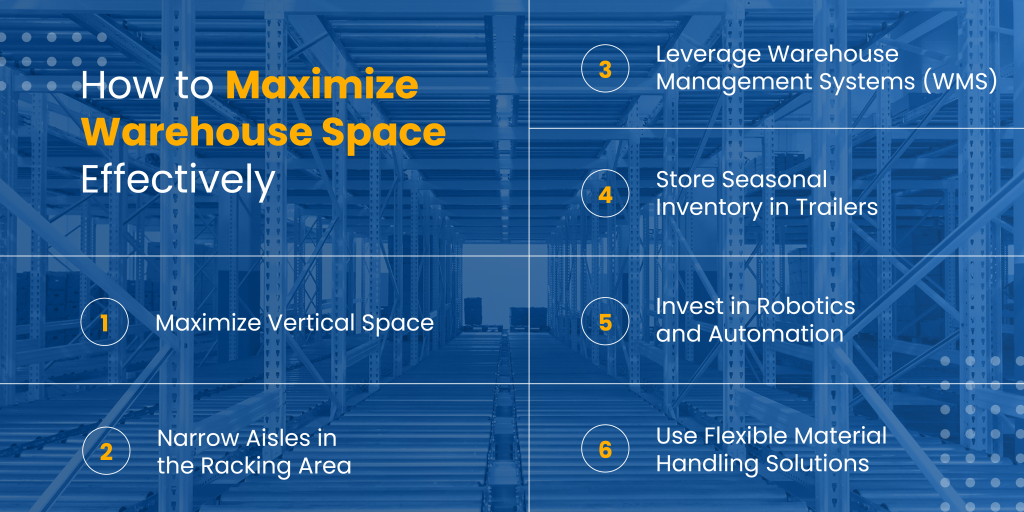Limited space in your warehouse or distribution center (DC) is one of the leading challenges in the supply chain. Typically, warehouses run out of space due to rapid growth, seasonal peaks, bulk discount buying, planned inventory builds for manufacturing shutdowns, facility consolidation, or during slow sales periods. These space shortages can create inefficiencies, higher operational costs, and safety risks.

What Happens When a Warehouse Runs Out of Space?
When your distribution center starts to run out of space, the most immediate problem is congestion. Congestion leads to inefficiencies, increasing labor, slowing operations, and decreasing worker productivity.
Imagine a two-car garage. If both vehicles are inside, there’s little room for lawn equipment, tools, or seasonal items. In a congested warehouse, products and machinery are constantly shuffled around, creating unnecessary work and wasted time.
Additionally, space issues in warehouses can have serious safety implications. With more equipment, products, and personnel crammed into a limited area, the risk of accidents increases. Forklifts and other machinery may struggle to navigate tight spaces, potentially damaging goods or causing injury to workers. Slowing down operations for safety reasons reduces productivity, adding another layer of inefficiency.
Top Reasons Why Warehouses Run Out of Space

While some storage issues arise due to growth (a positive sign for business), many space problems are tied to inventory mismanagement and operational inefficiencies. Here are the key reasons:
- Purchasing Overbuys: Bulk buying often seems like a great way to save money in the short term, but it can lead to excess stock and overcrowded shelves if not planned properly. Deep discounts on bulk purchases can result in unmanageable inventory levels, straining storage capacity.
- Obsolete or Dead Inventory: Obsolete inventory—also known as dead stock—occupies valuable space for months or even years. It doesn’t contribute to your sales, and in many cases, products may sit idle, gathering dust and taking up room that could be better used for active inventory.
- Seasonal Demand Fluctuations: Many businesses experience sharp fluctuations in demand, especially around holidays or specific seasons. This cyclical demand often leads to warehouses becoming overstocked for short periods, creating a temporary space crunch that’s hard to manage without long-term planning.
- Inadequate Forecasting: Poor demand forecasting can result in excessive inventory levels. If stock is purchased based on inaccurate sales projections, the warehouse may end up storing products that aren’t needed immediately, using up precious space that could be reserved for faster-moving items.
- Slow-Moving or Excess Safety Stock: In an effort to prevent stockouts, some businesses hold onto slow-moving products or keep large amounts of safety stock. While it’s important to have inventory buffers, too much can clog up valuable space and increase warehousing costs without delivering operational benefits.
- E-commerce Growth and Reverse Logistics: With the rise of e-commerce, the need for additional storage space has surged. More SKUs, faster turnover, and returns management (reverse logistics) can all contribute to space shortages. Warehouses today must not only store products but also accommodate packaging materials and returned goods, which further strains available storage space.
How to Maximize Warehouse Space Effectively

Recognizing the need for warehouse optimization is only the first step. The real challenge lies in implementing changes that maximize space without disrupting day-to-day operations. Here are six practical strategies to optimize when your warehouses run out of space:
- Maximize Vertical Space: One of the easiest ways to optimize your storage is by utilizing vertical space, which many warehouses do not take full advantage of. By stacking products higher, you can store more inventory without expanding the warehouse footprint. Ensure that your warehouse complies with fire safety regulations such as ESFR (Early Suppression, Fast Response) sprinkler systems, allowing inventory to be stored within 18 inches of the ceiling.
- Narrow Aisles in the Racking Area: Traditional aisles are usually 10 to 12 feet wide. By reducing aisle width and using narrow-aisle forklifts, you can save 15% to 20% of floor space, allowing more room for inventory. Specialized equipment makes it possible to access products safely, even in tighter spaces.
- Leverage Warehouse Management Systems (WMS): A warehouse management system (WMS), such as Hy-Tek’s IntraOneTM full-stack software, can streamline space usage by directing put-away processes. Instead of allowing workers to store pallets in the most convenient spot, a WMS directs them to the optimal location based on inventory type and availability. This prevents wasted space and minimizes unnecessary movement of products.
- Store Seasonal Inventory in Trailers: During periods of seasonal demand, consider using trailers as temporary storage. Many warehouses rent extra trailers to accommodate short-term surges in inventory without the need for costly expansions. This method helps manage excess products during peak seasons, especially for retailers.
- Invest in Robotics and Automation: Autonomous mobile robots (AMRs) can transport payloads and pallets up to 2,200 lbs. within the warehouse. By automating material handling, you reduce the need for human-operated machinery, freeing up space and increasing efficiency. AMRs can be customized to suit your warehouse’s specific needs, from transporting heavy items to aiding in order fulfillment.
- Use Flexible Material Handling Solutions: Modular material handling solutions enable you to create ‘pop-up’ operations during periods of unexpected demand. Portable equipment can be set up quickly, helping to manage surges in inventory without the need for permanent expansion. This is particularly useful during holiday seasons, product launches, or any period of high demand.
Leverage Third-Party Expertise for Space Optimization
There’s no one-size-fits-all solution when it comes to warehouse space optimization. The best approach involves combining several strategies tailored to the unique needs of your business. Regularly reviewing your storage plan ensures that your warehouse remains efficient, even as operations evolve.
Engaging warehouse experts can help you uncover creative, cost-effective solutions to maximize your existing space without the need for expansion. At Hy-Tek, we specialize in warehouse design and optimization, offering expert guidance to help you make the most of your space.

Conclusion
Running out of space in your distribution center is a common but manageable challenge. By using vertical space, implementing advanced warehouse management systems, and adopting new technologies like robotics, you can optimize your warehouse and improve storage density.
At Hy-Tek, we combine leading-edge engineering and strategic selection of software, automation equipment, and robotics to deliver best-in-class fulfillment and distribution solutions. Whether your goal is to increase efficiency or accommodate business growth, our team of experts is here to help.
Contact Hy-Tek’s strategic services team to explore how we can help you improve storage efficiency and streamline your distribution center.




